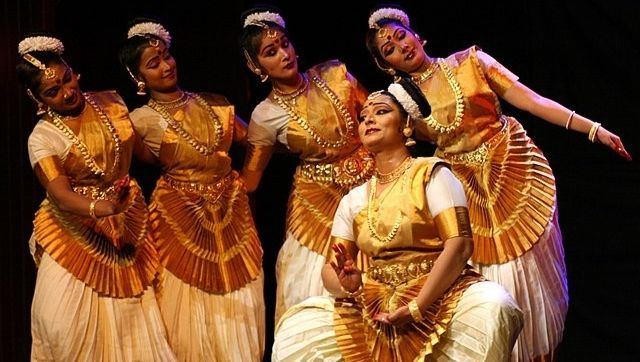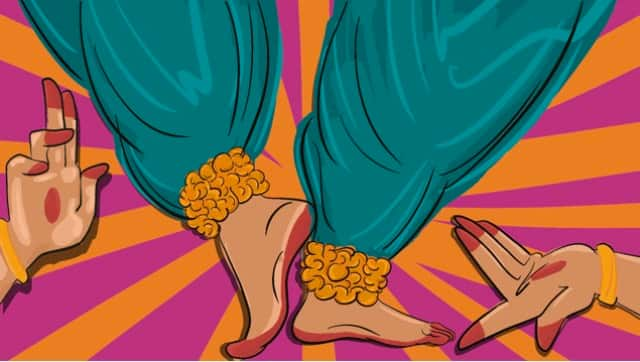Indian classical dances – celebrated across the globe for their enriching and mesmerising virtuosity – can be traced back to centuries-old ways of storytelling, performed as much for entertainment as for the spread of cultures and knowledge. Each classical form is built upon layers of complex histories that often converge at the intersection of culture, art, politics and even conflict, readjusting its structures and boundaries in the light of revolution and reform. Consequently, varying styles of the art form find new homes and families to become gharanas, yet other dance forms are added to the ever-dynamic definition of what constitutes as classical. This series is an attempt to reacquaint the connoisseur and engage the uninitiated in the vibrant facets of the eight classical dance forms of India by offering a glimpse into the history, performance, attire, comportment and musical accompaniments that give colour, form and rhythm to these cultural legacies. In the second essay, a look at the enchanting Mohiniyattam. Where numerous indigenous cultural and artistic practices were stigmatised or thrust into obscurity during the colonial era, it was only the nationalist revivalist movement beginning in the early 20th century that sought a reinvention of these very art forms in the quest to build a national identity upon the bedrock of cultural diversity and virtuosity. One such dance form deemed promiscuous and unworthy of the ‘gentrified gaze’ in the erstwhile British rule – thus banned from practice – was Mohiniyattam, that through multiple socio-cultural campaigns not only took its rightful place as a celebrated art form of Kerala but has also been recognised as one of the country’s eight classical dances by the Sangeet Natak Akademi of India. Socio-cultural and mythological beginnings According to certain historical sources, the earliest mention of Mohiniyattam can be found in the 16th century text Vyavaharmala, while other sculptural references point to the practice of similar dance movements in practice since 6th-century India. However, as with most Indian classical dances, the legacy of Mohiniyattam too can be traced to ancient and medieval temple precincts where the dance was performed alongside verses recited by the priests. In Kerala and the areas abutting this region, prayers and incantations were often elucidated using facial expressions and mudras [hand gestures] by the devdasis residing within the temples. Subsequent political upheavals forced the artists out of the temple sites, and it was during the reign of the 18th century monarch of Travancore, Maharaja Swathi Thirunal Rama Varma, that their art was codified and formalised into Mohiniyattam as it is known in its present structure. Evidently, Mohiniyattam has had a fascinating trajectory whose etymological source can be traced to mythological stories passed down through generations. Mohiniyattam then literally means the dance of Mohini, where attam in Malayalam stands for dance or rhythmic movements, and Mohini refers to the mesmerizing avatar of Lord Vishnu. In the story of the Samudra Manthan found in the Bhagvata Purana, the asuras [demons] and the devas [gods] churn the ocean to draw the Amrit or the elixir of life out from within the seas. In a subsequent battle between the two forces, the asuras manage to win the nectar that would grant them eternal life. But Lord Vishnu intervenes, and in order to take the Amrit away from the demons, assumes the form of the sultry seductress Mohini. Her evocative gestures and titillating dance so intoxicate the asuras that they lose their hold over the coveted elixir and hand it over to this temptress, who then whisks it away to the realm of the gods. [caption id=“attachment_10414441” align=“alignnone” width=“640”]  Mohiniyattam[/caption] Such an interpretation of the story of Mohini’s dance translates into a classical art form, that is most renowned for its soft and alluring movement vocabulary, its captivating abhinaya, and its lasya anga or the calming and graceful dance technique that is in contrast to the much more rigorous movements of the tandava structure. Inevitably, it was this blend of spiritual and amorous themes infused in the erotic movement vocabulary of the shringara rasa [emotion of love] that came under attack during the pre-Independence period, resulting in a ban on the performance and practice of Mohiniyattam. **Revival post 20***th** century The curtailment of Mohiniyattam came to be heavily contested particularly by artists like the eminent poet-laureate Vallathol Narayana Menon, who went on to introduce the dance form in his cultural institution, Kerala Kalamandalam. Yet, even as the 20th century resurgence of Mohiniyattam meant a cultural rebirth of an art influenced by multiple folk dances like Kaikottikali or the Tiruvatirakali, it was by this time a sanitized version of a classical dance whose more subversive and audacious repository had already been lost to the annals of history. What were retained were the romantic themes with undertones of communion with the divine like the love between Radha and Krishna or the qualms of a nayika [heroine] pining for her lover, performed to the poetry and songs composed in the Manipravala, a literary blend of Malayalam and Sanskrit. Nonetheless, in its contemporary form, exponents of Mohiniyattam, like the mother-daughter duo Jayashree and Sujatha Nair, continue to experiment with broader themes of abhinaya within the classical repertoire so that in one such instance, they explore the episode of love and yearning not through the lens of the nayika but through that of her sakhi [her bosom friend]. Performance practice Mohiniyattam is a classical art form with tremendous leanings towards nritya or the aesthetics of abhinaya so much so that oftentimes, it is recognised simply for its widespread incorporation of the ashtapadi in a recital. A poem with eight verses, this is most often an ode to Krishna, and describes his love and relationship with the gopis of Vrindavan. In the decades following Vallathol’s influence on Mohiniyattam, the Omanatinkal or a lullaby-like verse introduced by the master poet have also become a part of its recital. However, a typical concert does involve a codified structure which can be attributed to the propagation of Mohiniyattam by prolific artists like Kalamandalam Kalyanikutty Amma, and the shaping of the art into a succinct recital that could be taken to the stage amidst the shifts in cultural spaces from temples and courts to theatres and performance halls. As such, similar to a typical Bharatnatyam or Kuchipudi concert, Mohiniyattam too consists of such compositions like Cholkettu or a prayer, the Jatiswaram [a technical composition], the Varanam and Padam [both songs or poems that narrate stories], and even the Tillana. In its post-Independence revival, a novice would begin the study of Mohiniyattam with four major adavu or movements integral to the dance that were formalised in the Kalamandalam school namely, Taganam, Jaganam, Dhaganam, and Sammishram. Each of these connotes a separate vocabulary where Tagnam refers to phrases like thaiyum tatta, Jaganam denotes sounds akin to jagam thari kuma thari taa, Dhaganam includes the stronger sounds like dhikdadhinnam thadinnam, and Sammishram is a combination of all these varied phrases. Movement vocabulary Following the pattern set forth in Bharat Muni’s treatise, the Natya Shastra, Mohiniyattam in its classical structure is divided into the segments of the technical and the abhinaya. But the most distinctive and therefore distinguished feature of this art form lies its attention to the physical self. For Mohiniyattam, abhinaya transcends rasa nishpatti [the birth of the rasa] manifested in facial expressions alone to become a process that employs overt body language while delivering a deeply romantic and spiritual performance. The footwork is light, and more emphasis is placed on the movements of the forearms and on mudras that are informed by ancient Kathakali treatises. Clad most often in a simple white sari bordered with golden brocade [known as the kasavu in Malayalam], the artist transforms her graceful, pristine physical body into a subtle but provocative medium of conveying the more poignant emotions of making love, reminiscing in lost love or even preparing to receive a lover, through movements that invoke passion and desire. A Mohiniyattam danseuse maintains an erect torso with knees bent forwards and readies herself for the rhythm with which she can attain the ati bhanga or the swaying of the hips similar to the swaying of the coconut trunks or the paddy fields and palm trees integral to Kerala’s landscape. This rhythm is created with musical instruments like the mridangam, the idakka, and cymbals as well as the melodies of the veena and the flute.
Mohiniyattam, from being categorised as a dance of the vaishya or the prostitute to receiving recognition as a prolific art form and a codification into the realm of the ‘classical,’ has perhaps been one of the few dance styles to have undergone such humongous shifts through history.
Within its contemporary practice too, Mohiniyattam continues to be a topic of discussion be it for its music, as to whether it ought to follow the Carnatic school or the Sopana Sangeetham [temple music] or in its practice of adavus so integral to Kalamandalam. In all this, Mohiniyattam is remarkable for its enigmatic performance style which nurtures and sustains its sublime repertoire, and its prowess lies in its ability to flourish despite the persistent contestations and debates around its performance practice. Read Part 1 of the Know Your Classical Dances series here . [caption id=“attachment_10383621” align=“alignnone” width=“640”]  Know Your Classical Dances. Illustration by Poorti Purohit[/caption] Aishwarya Sahasrabudhe writes about art, culture, books, and entertainment. Currently, she has returned to school to study the intersections between gender, culture, and development. The writer is a Kathak Visharad practicing and performing the classical dance form for over a decade. Read all the Latest News , Trending News , Cricket News , Bollywood News , India News and Entertainment News here. Follow us on Facebook, Twitter and Instagram.


)
)
)
)
)
)
)
)
)



